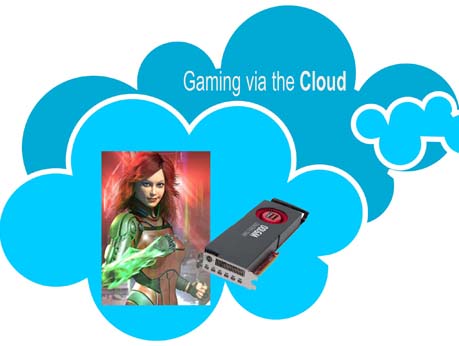
Backed by powerful graphics cards, like those recently launched by AMD, servers are beaming the most demanding console games to millions of mobile phones and tablets -- via the Cloud
By Vishnu Anand
Bangalore, September 29 2014: You can't afford the asking price of gaming consoles like XBox 360 and PlayStation. But you still crave the sheer joystick joy of one of those high octane, graphics-rich 3-D first person shooter or multiplayer games. Till recently we'd have said, sorry guys, don't crave what your purse can't provide. Not anymore.
Welcome to the just emerging world of cloud gaming. No, we're not talking about the PC games that date back to the generation of Prince of Persia and Quake, or even the more retro MS DOS based games. But the cream of today's serious number crunchers from Call of Duty to Crysis; Hitman to Tomb Raider.
Gaming without actually installing the game on your PC, tablet or mobile is the newest wave of gaming. Simply put, Cloud gaming is essentially gaming on-demand, where you can ‘invoke’ a game which is sitting on a master server or the Cloud, and stream it on your device.
It may sound simple, but the challenge is, each game is built on a different platform, intended for use on a particular set of devices. Enabling them to be streamed on new generation mobile devices, without hampering user experience requires technology horsepower on the backend – both hardware and software.
The challenge is to provide HD visual quality at the very least, with minimal latency -- which is the lag between the action of the player and the reaction of the computer on which you are playing. For first person shooters or driving games, one needs a latency of less than 50milli seconds and preferably less than 30ms.
Then there is the memory-gobbling task of rendering -- the process of add shading, color and lamination to a 2-D or 3-D frame in order to create life-like images on a screen.
You need to do this within the available network bandwidth of the player and still ensure a compelling and responsive gaming experience from any device over the internet.
Sounds like a tall order? It can be done -- but it requires serious graphic computing power at the server end -- almost equal to a supercomputer on a desktop, performing 2 to 3 teraflops -- that's 2000 -- 3000 billion operations a second. It's not enough if your desktop machine is up to the task: the GPU or graphical processing unit must match the PC's central processor.
Last week in Goa, AMD unveiled a suite of new graphics cards that will help games developers and service providers in India, roll out an increasing number of high end games -- via the cloud. This means their servers do all the heavy lifting -- graphics -wise, letting players enjoy the experience on resource-thin devices like mobile phones or tablets. Soon available in India, AMD cards like FirePro W8100 and W 9100 work at between 2 T Flops and 5 T Flops depending on the task at hand, using 16 GB of ultra fast on board memory , take on all the graphics intensive tasks and trick players into thinking it's happening on their screens.
Global companies like Gaikai, OnLive and CiiNOW have started to offer streaming games that cater to every possible genre of gaming from strategy to sports to warfare. They are also able to breathe life into vintage PC games that are no longer available on consoles. With the required hardware now available in India, it is only a matter of time before gaming fans in India are offered similar services -- that will make the lurch towards ultra high definition screens a worthwhile exercise.
______________________________________________________________________________________________________________________
8K on the way
There's a saying in technology: If it work's, it's obsolete. We are only just getting set to experience ultra high definition or "4K" on our TV sets after Diwali -- if we have a lakh or two of loose change. Raja Koduri, AMD's Corporate Vice President, Visual Computing, says "8K" is just a year away -- that's 8 times better, sharper than the HD screen.
"8K display technologies are already in the blueprint phase, and in the months to come, a slew of manufacturers will embrace the technology and release products."
For gaming this means something beyond "near real". Come end 2015 and the new name of the game will be "Photo-real".
____________________________________________________________________________________________________________________